When planning and designing a building with structural steel, you may not realise the variety of structural steels available.
Known for its versatility and durability, structural steel is commonly used across construction projects. However, there are various grades and types of structural steel, each with their own unique characteristics and applications, which should be carefully selected depending on their use.
We take it back to basics in this article, and examine the different types of structural steel you can use for your construction project.
What is Structural Steel?
Structural steel is a versatile and durable material that is commonly used in construction projects. It's known for its strength and ability to withstand heavy loads, making it a popular choice for building structures across residential, commercial, and industrial sectors.
To be categorised as a structural steel, the material is typically an alloy of iron and carbon, with a carbon content reaching up to 2.1% of its weight. The carbon content directly affects the yield strength of the steel.
Structural steelwork is usually used to create the skeleton frame of a building, consisting of columns and beams that are riveted, bolted, or welded together. The most commonly used type of steel in building materials is low-carbon steel, also known as mild steel. It contains a carbon content ranging from 0.04% to 0.3%, making it both strong and ductile.
Why Use Steel?
Structural steel offers numerous advantages that make it an ideal choice for construction. One of the key benefits is its exceptional strength-to-weight ratio, which allows for the creation of structures that are both sturdy and lightweight. This not only reduces material and transportation costs but also makes construction more efficient.
Its inherent fire resistance and resistance to the outside elements further enhance its durability and longevity, making it a sustainable material choice.
Structural Steel Types and Grades
There are several types of structural steel grades, including carbon steels, high-strength low-alloy steels, forged steels, and quenched and tempered alloy steels.
Carbon Steels
Carbon steels can be identified when no other alloying element (such as tungsten or nickel) is added, plus the copper content doesn't exceed 0.4 to 0.6%, manganese doesn't exceed 1.6%, and silicone doesn't exceed 0.6%. Carbon steels are high-strength steels, making them suitable for structural pipe and tubing.
Low-carbon, medium-carbon, and high-carbon steels are available with varying carbon contents.
High-Strength Low-Alloy Steels
To enhance mechanical properties and corrosion resistance, high-strength low-alloy steels incorporate trace amounts of various alloying elements such as chromium and nickel. These elements, along with manganese content up to 2%, help enhance the strength and durability of the steel, allowing it to withstand higher levels of stress, as well as resistance to corrosion.
High-strength low-alloy steels are commonly used in harsh environments because of these properties, as well as structural shapes and steel plates.
Forged Steels
Forged steel has been shaped and strengthened through forging. This process involves heating the steel and applying pressure to shape it whilst it is still in a solid state.
One of the benefits of this is enhanced strength. The forging process ensures a uniform grain structure, eliminating voids and gas bubbles. This results in steel that's stronger and more resistant to wear and tear, making forged steel suitable for a variety of structural applications.
Quenched and Tempered Alloy Steels
These steels are a type of structural steel that undergo a special heat treatment process to enhance their properties.
During quenching and tempering, the steel is heated to a high temperature and then rapidly cooled in a cooling medium like water, oil, air, or nitrogen. This rapid cooling, known as quenching, helps to create a hardened structure in the steel, making it tougher and less brittle.
After quenching, the steel is then tempered, which further increases its strength and durability. The combination of quenching and tempering results in a higher-strength structural steel that is able to withstand heavy loads, impacts, and harsh environments.
Common Types of Structural Steel
Structural steel can take many forms within construction. The structural steels listed below are some of the most common types.
It’s important to note that whilst these shapes are found throughout the globe, there are different standards the structural steel type must adhere to depending on where it is used. In the UK, our manufactured structural steel products must adhere to the British Standard EN-1090.
Universal Beams
Known for its H-shaped profile and ability to withstand bending loads, the versatile Universal beam has become a staple in the construction industry.
Universal beams are designed to efficiently carry both shear and bending loads, making them a reliable choice for load-bearing structural applications.
H-beams are easily confused with I-beams, but there are some key differences. For instance, I-beams have a thinner vertical web and tapered horizontal flanges, compared to the thicker web and equal, parallel flanges of the H-beam – making the H-beam the stronger alternative in many cases.
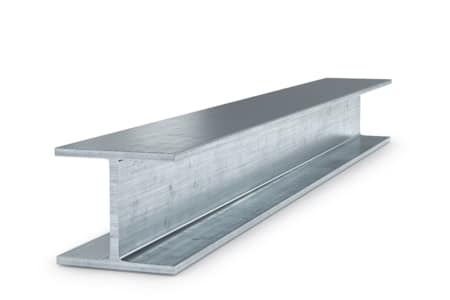
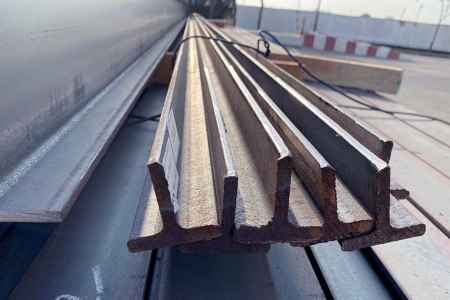
Tee Sections
Tee sections, also known as T-beams or T-bars because of their profile cross-section, offer increased resistance, making them a valuable structural steel type in construction, especially for applications with increased aestheticism.
Tee sections also eliminate the need for rebars and provide significant savings by reducing the need for additional reinforcement.
Parallel Flange Channels
These U-shaped beams, also known as C-sections, are perfect for supporting floor joists and other load-bearing applications. With their right-angled corners and parallel sides, they offer a high strength-to-weight ratio and can be used as part of a building's framework. Parallel flange channels offer:
- Increased strength and durability.
- Similar uses to angled sections.
- Availability in various sizes, with the two sides always the same length.
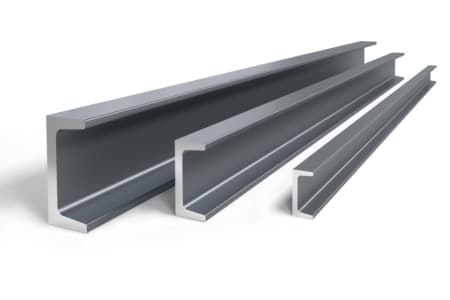
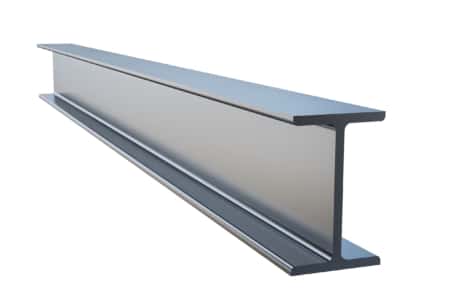
Tapered Flange Beams
Tapered flange beams, also known as I-beams, are similar in design to the Universal beam. Unlike the Universal H-beam, however, the I-beam features flanges that taper at an angle of 98 degrees.
The flanges reduce in thickness on one end, creating a functional and lightweight design that is commonly used as a cross-section for girders or to support other beams in construction.
Angled Sections
These strong and L-shaped supports have a versatile application within construction. The leg lengths of the angled section can be either equal or unequal, however, the legs are most likely to be perpendicular at a 90-degree angle.
Whilst there are many applications for angled sections, they can be commonly found in roof trusses and as structural supports for warehouses, residential houses, bridges and more.
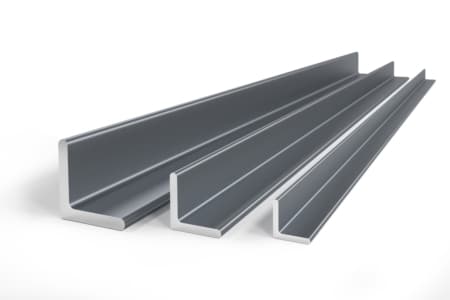
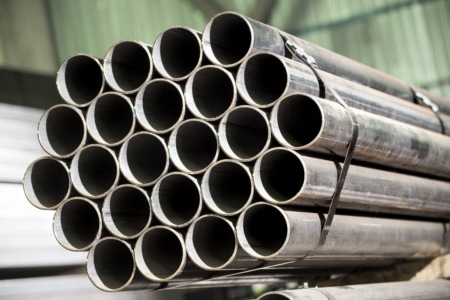
Circular Hollow Sections
Circular hollow sections are structural steel pipes or tubes, with a hollow shape or cross-section, also known as HSS-shape. They are ideal for withstanding multi-axis loading processes and are commonly used in various construction projects due to their uniform wall thickness. This provides better torsion resistance compared to the tapered flange variety of structural steel types. This means they can effectively handle loads that come in different directions, making them a reliable choice for demanding steel projects.
Whilst this section focuses on circular hollow sections in particular, hollow sections are available in a range of shapes – including square, rectangular, elliptical and more.
Bearing Piles
When it comes to creating a stable foundation in challenging soil conditions, bearing piles are the most suitable structural steel type. These H-shaped steel components are designed to transfer the load effectively through the pile to its tip, ensuring durability and efficiency.
Bearing piles can bear more than 1,000 tonnes of weight and work best in densely packed soil, which offers more resistance to the tip. They are the perfect choice when a solid foundation cannot be found or created at the work site.
H-Piles, Pipe-Piles, Disc Piles, and Screw Piles are the most common types of bearing piles used in construction. With their deep foundation systems, bearing piles provide stability and structural soundness, making them an essential part of any construction project.
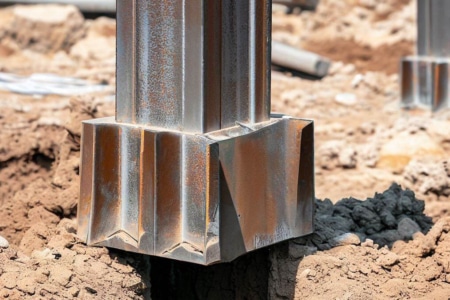
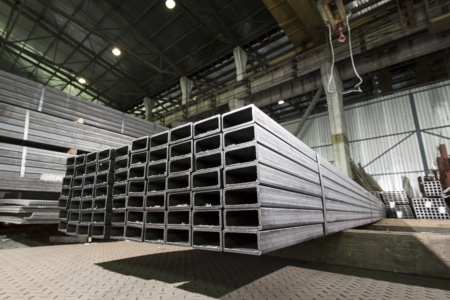
Rectangular Hollow Sections
As previously mentioned, hollow sections are available in a variety of shapes – and one of the most common shapes for use in construction is the rectangular hollow section.
Rectangular hollow sections have flat surfaces and high torsional resistance; the flat surfaces of rectangular hollow sections make them ideal for joining different components together.
Their high torsional resistance ensures that they can withstand twisting forces without deforming or failing, making rectangular hollow sections reliable and durable for various applications.
Flat Sections
Flat sections are commonly relied upon in a variety of structures as a strengthening tool. These flat pieces of structural steel can be easily cut and processed, before being attached to other sections within a structure, reinforcing them. Also known as plates, they are found in wall cladding, panelling, and even decorative implements that enhance the appearance of both building interiors and exteriors – though they will require additional finishing operations for this.
Steel plates can also serve as base plates, where they are attached to columns to achieve a better load distribution within the soil in construction projects where the foundation is challenging to work with.
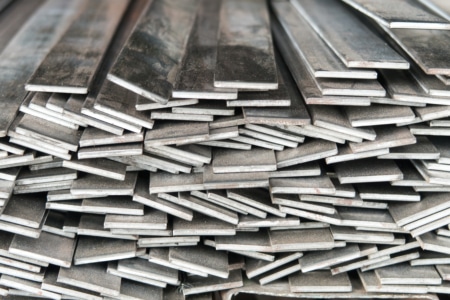
When considering the most appropriate structural steel for your construction project, there are two main considerations. Firstly, the steel grade; from carbon steel to alloy steel, each type has its own unique properties and uses. secondly, consider the type of steel profiles you require by discussing project requirements with a structural engineer.
You may choose to use a combination of both grades and types within your project, making the most of the benefits structural steel has to offer.
Still unsure about which structural steel type is most appropriate? Bromsgrove Steel has the experience and expertise to guide you through it. As part of this, we can provide bespoke structural steel design services for a range of residential, commercial, and industrial applications. Get in touch today to find out more!
Read more...